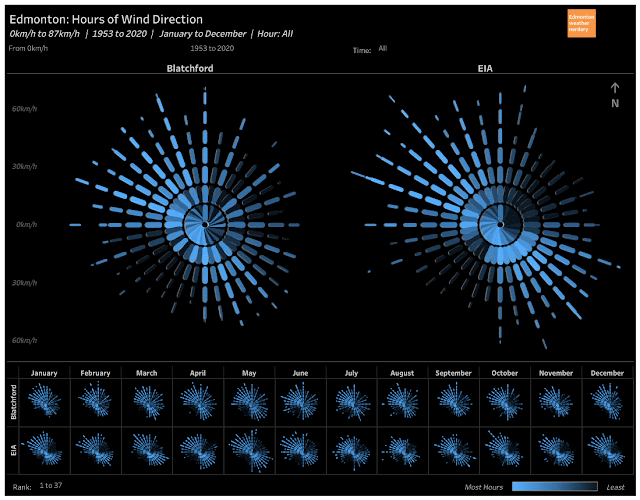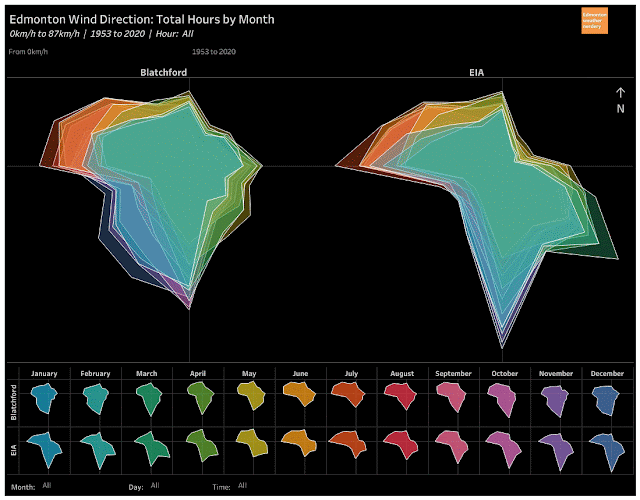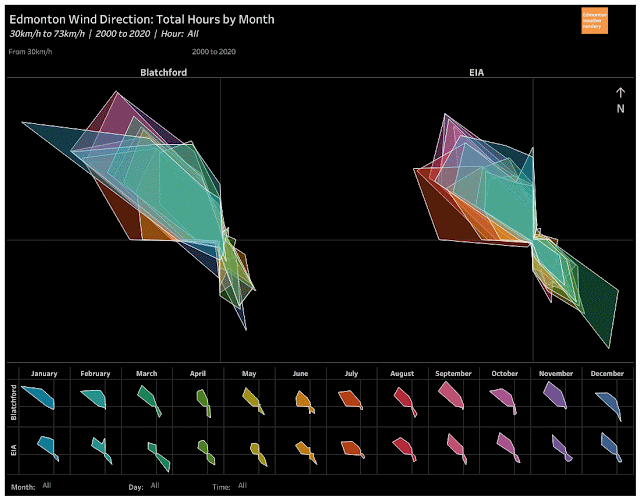Today we reach the end of our epic look at Wind in Edmonton. A 9-part series is obviously excessive, but each question led to another question which led to another dashboard, and that's how we ended here.
Something that we saw in the earlier parts of our look at wind was that Edmonton is not as windy as it used to be. And we saw that the 1960s in particular were windy across the board: average windspeeds, peak windspeeds, number of wind days, wind gusts, etc. And that raises the question of why?
We couldn't end this series without at least trying to dig into the mystery of the windy 1960s, and so today we are going to compare Edmonton to Calgary & Winnipeg. Often at Edmonton Weather Nerdery we also have the data for Vancouver, Montréal, Toronoto, etc. but for the wind data we are going to limit it to just Edmonton, Calgary, & Winnipeg. The wind uses hourly data, so there is 24x more of it than the daily temperatures and precipitation which we normally do.
So today we will run through many of the charts which we have already seen, but with Calgary & Winnipeg included as well. And we will start at the beginning:
Is it windier than it used to be?
And again, the answer is: nope.
Here we have the strongest gusts, the windiest hour, and the average windspeed for each year, and for all three cities the numbers are lower than they used to be. For Calgary it has been a gradual decline, whereas for Winnipeg it was more of a big step down in the early 1970s, and mostly flat after that.
Windy Months
In the top part of this chart each of the coloured blobs represents a month which was windier than average for the city.
- For Edmonton we saw that at both Blatchford and the International our windiest months were really clustered in the late-1960s and early-1970s.
- Calgary is a little bit different. Most of its windiest months are between 1960-1975, and things really taper-off after about 1990.
- And Winnipeg is also a bit different, with most of its windiest months spread from 1953-1970. Then from 1970-today there is a fairly consistent sprinkling of wind~ish months. And I don't know what happened in 1991, but September-December had four top-20 months in a row.
So all three cities have fewer windy months than they used, but that the pattern of those windy months is different.
It's also interesting that Calgary & Winnipeg have had a lot of windy months in the winter, whereas for Edmonton that never really happened outside of the very tight window of 1967-1971.
How many windy days do we get each year?
Here we have the number of days each year which recorded a windspeed of 60km/h or more. 60km/h was chosen here as an example, but you can use the slider to look at 30km/h or 50km/h too.
All of the windspeeds look something like this though, with a lot of windy days in the 1953-1975 range, and a lot few windy days since then.
It is also interesting to see how many fewer windy days Edmonton gets compared to Calgary or Winnipeg, and that that was also the case 60 years ago. In the windy 60s Edmonton averaged two 60km/h days each year, while Calgary had 10 and Winnipeg had 6.
For 40km/h days Edmonton used to average 60, compared to 110 in Calgary and 100 in Winnipeg. In recent years Edmonton has averaged 30 days which hit 40km/h, compared to about 60 in Calgary and 50 in Winnipeg.
Gusty Days
Here we have all of the days with wind gusts of 100km/h or more, and for all three cities the bubbles are a lot less common than they used to be. Winnipeg has not had a day with 100km/h wind gusts since June 21, 2004.
(although Winnipeg is missing gust data for 1997-2004, while Blatchford is missing 1995-2005)
So by all accounts Edmonton, Calgary & Winnipeg are all less windy than they used to be. But how do they compare to one another?
City Comparisons - Average Windspeed
Here we have a comparisons of the average windspeed throughout the year for the 3 cities. This uses all the data for 1953-today. Up top we see each of the cities individually, but at the bottom we can see how they compare to one another.
All 3 of the cities have their highest average windspeeds in May, and are lowest at the end of August.
Surprisingly (to me, anyway) Winnipeg's average windspeed is about 5km/h (or 30%) higher than Edmonton's, although that depends a bit on the station. Winnipeg is on-average about 5km/h windier than the Edmonton International for most of the year, although the gap closes to 3km/h for June & July. For Blatchford the difference is 7-8km/h for most of the year, although it again narrows to 3km/h for June & July.
Calgary is also windier than Edmonton. Blatchford's average windspeed is about 4km/h less than Calgary's for most of the year, although that decreases to 1-2km/h for the summer. For the Edmonton International the difference is about 2-3km/h for the whole year.
And for Calgary vs Winnipeg, Winnipeg's average windspeed is about 3km/h higher than Calgary's for most of the year, except during July & August when they are a very close match.
City Comparisons - Windiest Hour Each Day
We can also use this chart to look at the average of the windiest hour for each day of the year. "Average Windiest Hour" is maybe slightly unclear, but the windspeed varies during the year as well as during the day. This is looking at the windiest of each day - January 1st, May 17th, August 23rd... - and finding the average for each city.
Winnipeg and Calgary are both at about 30km/h for most of the year: things increase a bit to 33km/h in May and fall to 27km/h in August. The two Edmonton stations are closer to 23km/h for most of the year, with a peak of 28km/h in May and a bottom of 20km/h in August.
And for our final chart of the day, here is how the windspeed varies throughout the day.
We are looking at 60+ years of data here, but on-average all three cities are windiest during the afternoon. For Edmonton and Winnipeg the peak is 1-2PM, while for Calgary its 3-4PM. We can also see the gaps in average windspeed, with Winnipeg's line generally about 5km/h higher than Edmonton's, and with Calgary fitting in the middle.
The End
And so at long last that brings us to the end of our look at Wind in Edmonton.
In previous posts we saw that Edmonton is not as windy as it used to be, and today we saw that something similar is true for Calgary and Winnipeg. The patterns are not identical: Edmonton's peak was firmly in 1965~1973, Winnipeg's was 1953~1975, and Calgary's 1960-1975 was with another big drop after 1990.
When wind recordings started 60 years ago these airports were all new, and in the decade to follow all of the would have undergone construction and expansion. So maybe that the wind patterns were changed as the airports were first developed? Or maybe the wind itself actually has changed? I do not know the answer to that question, and will probably never know the answer.













